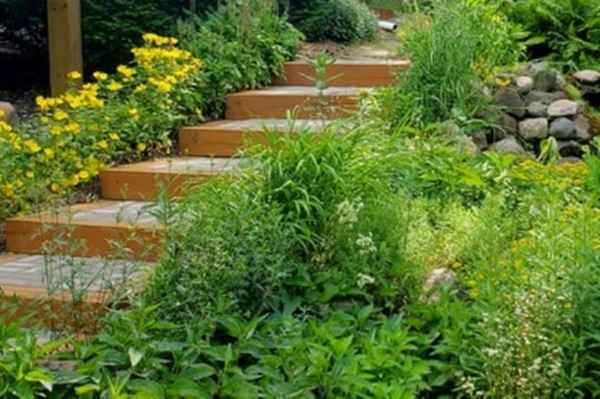Select the Best Plants for Your Landscape: Expert Tips & Advice

Creating a beautiful and functional landscape starts with selecting the right plants for your unique environment.
Whether you're planning a vibrant perennial garden, a low-maintenance yard, or a design that supports local wildlife, choosing plants plays a critical role. The right selection enhances your outdoor space and ensures long-term sustainability and harmony with the local ecosystem.
This article will guide you through key considerations when choosing plants for your landscape, like what plants work best for low-maintenance designs, which native species thrive in different climates, and the differences between perennials and annuals in landscaping. Read on to create a thriving and tailored outdoor environment!
Best Plants for Low-Maintenance Landscaping
Low-maintenance landscaping prioritizes plants that require minimal watering, pruning, and fertilizing while still delivering aesthetic appeal.
Native plants often excel, naturally adapting to the local climate and soil conditions. For instance, in Minnesota, options like prairie grasses, coneflowers, and sedum are excellent for creating visually appealing yet hardy landscapes.
Perennials such as black-eyed Susans, hostas, and daylilies are also great choices for a low-maintenance garden. These plants return year after year with little intervention, reducing the need for replanting.
Incorporating ground covers like creeping thyme or ajuga can further simplify upkeep by minimizing weed growth and maintaining consistent soil coverage.
Consider layering plants of different heights and textures to design a low-maintenance garden that stays vibrant throughout the seasons.
Incorporating mulching techniques can also help conserve soil moisture and reduce the need for irrigation.
Native Plants That Thrive in Different Climates
Native plants are integral to sustainable landscaping because they thrive in the climate and soil conditions where they naturally occur.
Wild lupine, bee balm, and little bluestem grass provide beauty and resilience against harsh winters in colder regions like Minnesota. Conversely, succulents like agave or yucca and drought-resistant shrubs like sagebrush dominate in arid climates.
For regions with mild weather, native ferns, wildflowers, and broadleaf shrubs can thrive with minimal care.
Choosing plants suited to your USDA hardiness zone ensures optimal growth and longevity. Consulting local nurseries or landscaping professionals can provide insight into which species best suits your area.
Integrating native plants into your landscape ensures lower maintenance and supports local ecosystems. They attract pollinators, improve soil health, and require fewer resources than exotic species. Explore local extension resources for more guidance.
Perennials vs. Annuals in Design
Perennials and annuals offer unique advantages for landscaping design. Perennials, like coneflowers and hydrangeas, return year after year, making them cost-effective and low-maintenance.
These plants are excellent for creating long-lasting garden structures and providing consistency in landscape design.
On the other hand, such as marigolds or petunias, annuals provide vibrant colors throughout a single growing season.
They are ideal for filling gaps in perennial gardens or adding seasonal accents to flower beds and containers. This flexibility allows you to refresh your garden’s appearance annually.
Combining perennials and annuals ensures a balance between longevity and seasonal vibrancy. For instance, framing a perennial garden with annual borders can create dynamic yet enduring designs. Rock Solid Landscape’s expertise can help you harmonize these elements for a cohesive aesthetic.
Attract Beneficial Wildlife With the Right Plants
Plants that attract beneficial wildlife are vital in promoting biodiversity and ecological balance in your landscape.
Native flowering plants like milkweed and asters are magnets for pollinators such as bees and butterflies. Berry-producing shrubs like elderberry or serviceberry also provide food sources for birds.
Consider planting tubular flowers such as red cardinal or trumpet vines to attract hummingbirds. These species enhance the visual appeal of your garden and support critical pollinator populations.
Grasses like switchgrass and ornamental sedge create habitats for small mammals and ground-nesting birds.
Incorporating diverse plant species can foster a thriving ecosystem. Avoid invasive species that could disrupt local habitats, and prioritize plants that offer shelter, food, and nesting opportunities for various wildlife.
Soil Type Can Impact Plant Selection
Soil type is a critical factor in plant health and growth:
- Sandy soils drain quickly and are suitable for drought-tolerant plants like lavender and rosemary.
- Clay soils, which retain moisture, are better for plants like irises and daylilies that thrive in wetter conditions.
- Loamy soils, often considered ideal, support many plants due to their balanced texture and nutrient content.
A soil test can help determine your soil’s pH, nutrient levels, and structure. You can select plants best suited for your soil conditions based on the results. For instance, acidic soils support azaleas and blueberries, while alkaline soils are better for lilacs and clematis.
Amending your soil with organic matter, such as compost or mulch, can improve its fertility and structure over time. Rock Solid Landscape recommends tailoring your plant selection to your specific soil type for optimal results. For more resources, visit their website.
How Rock Solid Services Can Help You Create Your Ideal Outdoor Space
Rock Solid Services specializes in helping clients select the perfect plants and design features to create stunning, functional outdoor spaces.
Our expertise ensures a cohesive, sustainable design tailored to your environment, from low-maintenance landscapes to intricate perennial gardens.
Our team’s knowledge of native plants and adaptability to different climates allows us to recommend species that thrive in your region. We also excel in designing gardens incorporating perennials and annuals for year-round beauty and seasonal flair.
Whether you want to attract beneficial wildlife or achieve a balance between form and function, our services provide the guidance and expertise needed to bring your vision to life. Contact us online or call 763-398-0739 today to start transforming your outdoor space or to request an estimate.